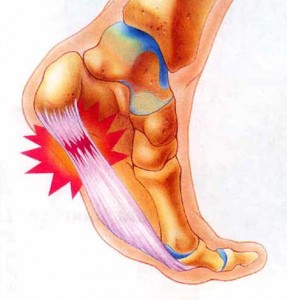
Plantar fasciitis is one of the most common causes of heel pain. It is due to inflammation of a thick band of tissue called the plantar fascia, which runs across the bottom of the foot, connecting the heel bone to the toes.
The chief diagnostic sign of these problems is pain in the bottom of the heel or arch when first standing, which gradually improves with walking. This pain may later return with continued walking. The pain usually subsides after a period of rest.
Under normal circumstances, the plantar fascia acts like a shock-absorbing bowstring, supporting the arch of the foot. But when the tension on the bowstring becomes too great, it creates small tears in the fascia. Repetitive stretching and tearing causes the fascia to become irritated or inflamed.
Maintaining a healthy weight minimizes the stress on the plantar fascia and choosing supportive shoes by avoiding high heels and buy shoes with a low to moderate heel, good arch support and shock absorbency. Do not go barefoot, especially on hard surfaces.
About 90 percent of people who suffer from plantar fasciitis recover with conservative treatments in just a few months. Anti-inflammatory drugs may ease pain and inflammation, although they do not treat the underlying problem. Shock wave therapy is a good form of treatment for this condition.
© 2021 Singapore Orthopaedic Centre for Spine & Sports Medicine. All Rights Reserved.
Designed By ArsEmporium.com
Connect with Us




